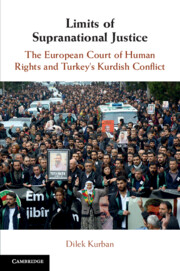Book contents
- Reviews
- Limits of Supranational Justice
- Limits of Supranational Justice
- Copyright page
- Dedication
- Contents
- Acknowledgements
- Interviews
- Abbreviations
- 1 Introduction
- Part I Historical Background
- 2 Human Rights and Democracy under European Watch
- 3 The Kurdish Question in Historical Context
- 4 The Actors, Acts and Victims of State Violence
- Part II Kurdish Lawyers, the Turkish State and the ECtHR
- References
- Table of Cases
- Subject Index
2 - Human Rights and Democracy under European Watch
from Part I - Historical Background
Published online by Cambridge University Press: 30 October 2020
- Reviews
- Limits of Supranational Justice
- Limits of Supranational Justice
- Copyright page
- Dedication
- Contents
- Acknowledgements
- Interviews
- Abbreviations
- 1 Introduction
- Part I Historical Background
- 2 Human Rights and Democracy under European Watch
- 3 The Kurdish Question in Historical Context
- 4 The Actors, Acts and Victims of State Violence
- Part II Kurdish Lawyers, the Turkish State and the ECtHR
- References
- Table of Cases
- Subject Index
Summary
Part of the book's background chapters on the ECtHR's engagement in Turkey's Kurdish conflict, Chapter 2 seeks answers to the following puzzle: How is it that Turkey remains an authoritarian regime despite havig been part of the post-World War II international liberal democratic order? Arguing that the answer lies in the country's political history and sociological reality, it traces Turkey’s post-war tumultuous experience with electoral democracy, constitutionalism, human rights and minority protection against the backdrop of its engagement with international and European institutions, including the European Union and the Council of Europe. It argues that Turkey’s transition to polyarchy in 1950 has never translated into democratisation, which cannot be solely explained by frequent military interventions. Rather, authoritarianism has survived in Turkey due to unique social and political factors, including sustained electoral support for anti-democratic laws and policies, a tradition of a strong state immune to the internal checks of liberal democracy and the absence of a democratic culture.
Keywords
- Type
- Chapter
- Information
- Limits of Supranational JusticeThe European Court of Human Rights and Turkey's Kurdish Conflict, pp. 37 - 78Publisher: Cambridge University PressPrint publication year: 2020

